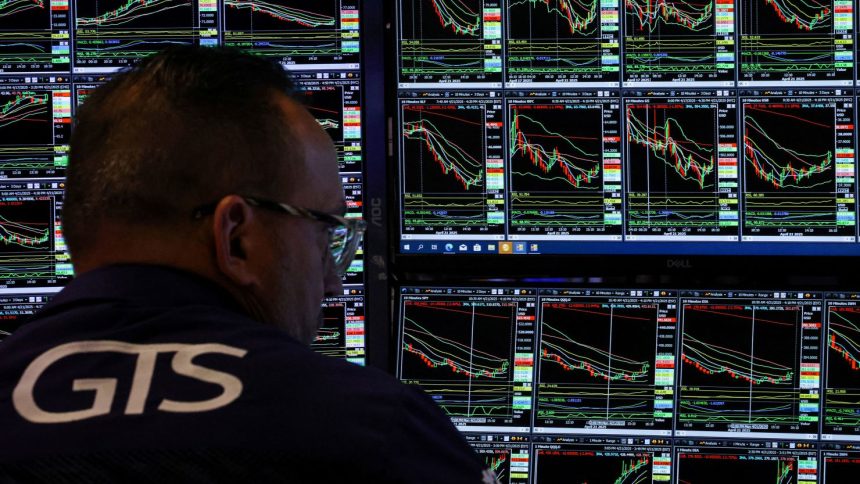A version of this story appeared in CNN Business’ Nightcap newsletter. To get it in your inbox, sign up for free here.
New York
CNN
—
President Donald Trump appears to be walking back some of his more extreme positioning on the economy — pivoting yet again on his signature tariff agenda and renewing concerns that his haphazard approach has already done serious economic damage.
On Tuesday, Trump softened on two key issues that had been giving Wall Street nightmares: He signaled openness to easing tariffs on China, and said he has “no intention” of firing Federal Reserve Chair Jerome Powell.
But the abrupt shift in tone was yet another reminder of the turbulence emanating from the White House that could push the US, and potentially other economies, into a recession.
More damaging than the tariffs themselves is the uncertainty the White House has created, said Wendy Edelberg, senior fellow in Economic Studies at the Brookings Institution, in an interview with CNN. “And the lurching hasn’t ended. In fact, this is simply another lurch.”
After an abysmal few weeks, US stocks surged Tuesday and Wednesday — a sign of Wall Street’s relief that the president appears to be heeding warnings from CEOs and close advisers who say his 145% tariffs on China aren’t sustainable. In an Oval Office gaggle with reporters Tuesday, Trump also refrained from attacking Powell. (It was a rare moment of restraint with regard to Powell, whom Trump has recently called a “major loser.” By Wednesday evening, Trump had resumed a more threatening tone, saying he “might call him.”)
But US stocks remain down 11% since Trump took office in January, battered by near-constant changes and mixed messaging from the White House about a tariff agenda that would fundamentally alter global trade and slam the brakes on economic growth.
Despite the recent rebound, more than $7 trillion in value has been erased from the S&P 500 since record highs were set just two months ago, according to FactSet data.
At this point, any sign that Trump is pulling back on tariffs or respecting decades of precedent protecting the Fed’s independence will land, at least temporarily, as a win for Wall Street.
“Markets are terrified about the dumb things he’s going to do, and when he doesn’t do them, they’re thrilled,” Justin Wolfers, professor of economics and public policy at the University of Michigan, told CNN.
But Wolfers and other economists expressed concern about the damage that’s already been done.
“It’s clear the economy will slow,” he said. “The question is how much.”
Forecasters broadly say there is an elevated risk of a recession this year — perhaps as high as a 50% to 70% chance. Virtually all note those odds are in flux because of Trump’s ever-shifting tariff agenda.
Even if all of the Trump 2.0 tariffs were unwound today, the US would still lose at least 1% of GDP just from the policy uncertainty, said Kent Smetters, professor of business economics and public policy at the University of Pennsylvania’s Wharton School. “We are projecting that GDP will eventually fall by 5% if all the tariffs are implemented.”
But to be clear: The Trump administration has not had any public discussion about unwinding other tariffs, which alone are extraordinarily aggressive. Tariffs on China may come down, but “they won’t be zero,” according to Trump. Remaining in place are 10% universal tariffs and 25% tariffs on autos, steel, aluminum and some Mexican and Canadian products.
According to a senior White House official who spoke to the Wall Street Journal, the current 145% tariffs on China could come down to “between roughly 50% and 65%.”
That would still be hugely disruptive.
Trump’s tariff headaches come with more than financial costs. Business leaders have been paralyzed by lack of clarity, as have some of America’s closest allies and trading partners around the globe.
“The US administration’s on-off tariff policy has led to a confidence crisis,” Gregory Daco, EY’s chief economist, said in a report on Wednesday.
It will take time to restore that lost confidence, especially given that US tariffs can be dialed up or down at any hour and often with little to no notice.
“Businesses don’t know which end is up,” Edelberg said, noting one Fed study that found 75% of businesses said they aren’t increasing their capital expenditures over the next six months. “Everyone is holding their breath because they don’t know what policy is going to be the law of the land tomorrow.”
That anxiety was evident in the Fed’s “beige book” report, a periodic survey of businesses across the country, released Wednesday. Across industries, firms said they are pausing or slowing hiring while they wait for clarity.
Meanwhile, America’s brand has taken a hit — both at home and abroad. Even some of the US’s closest allies and trading partners are struggling to see the logic behind Trump’s trade war.
“The US-Canada trading relationship is profoundly damaged, and will be forever,” Wolfers said. “It’s made it politically impossible for Canada to be pro-America … That damage is done.”



